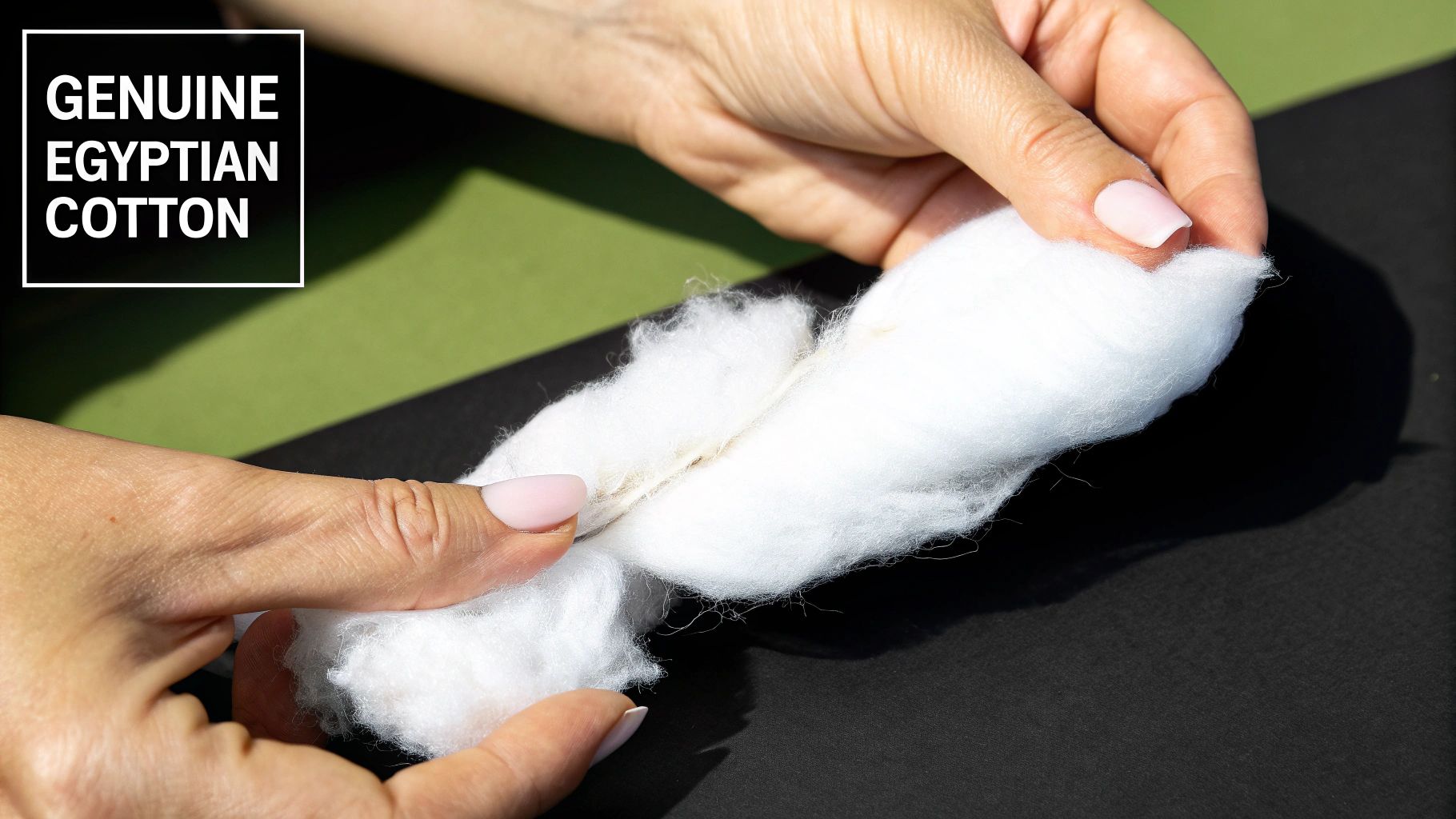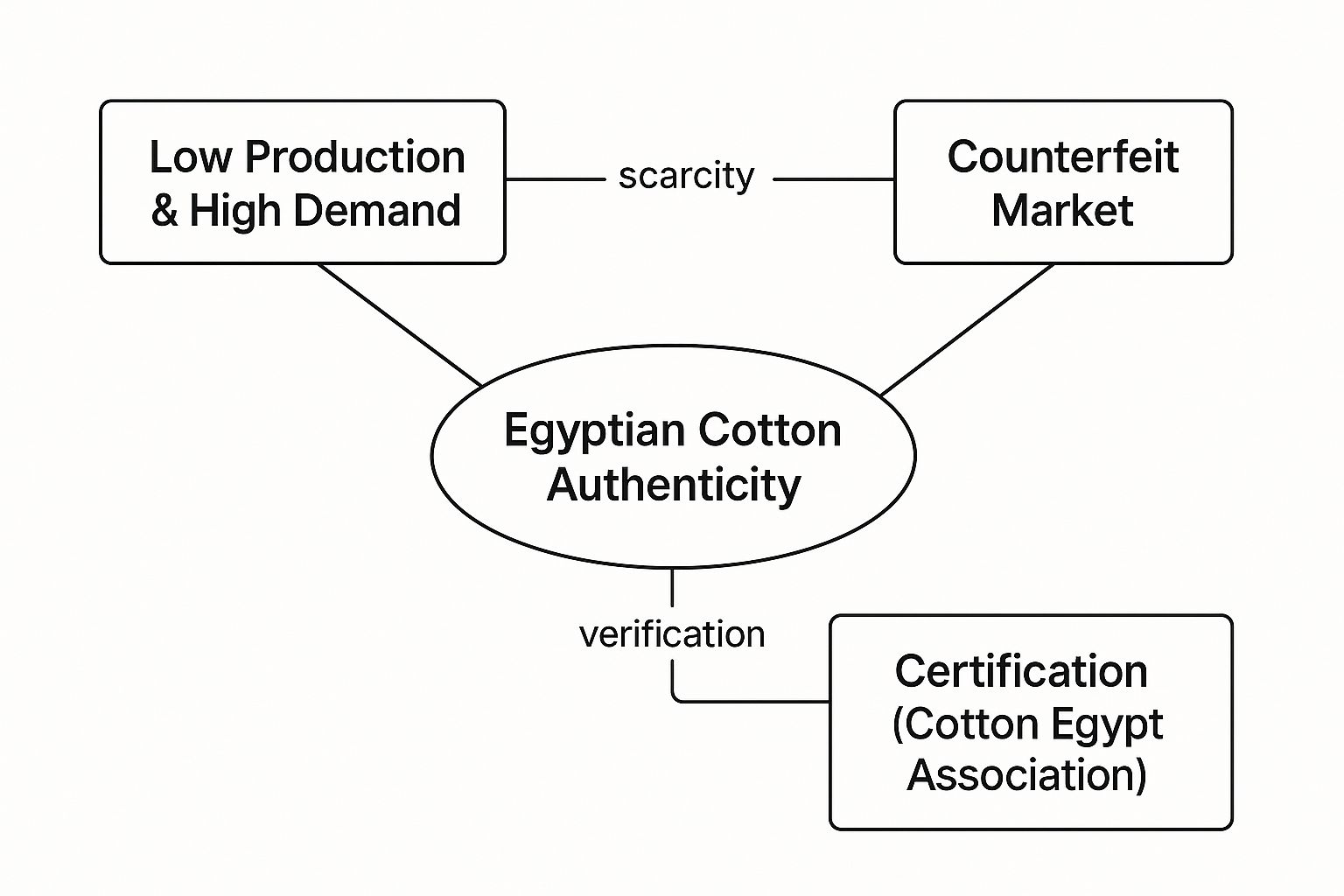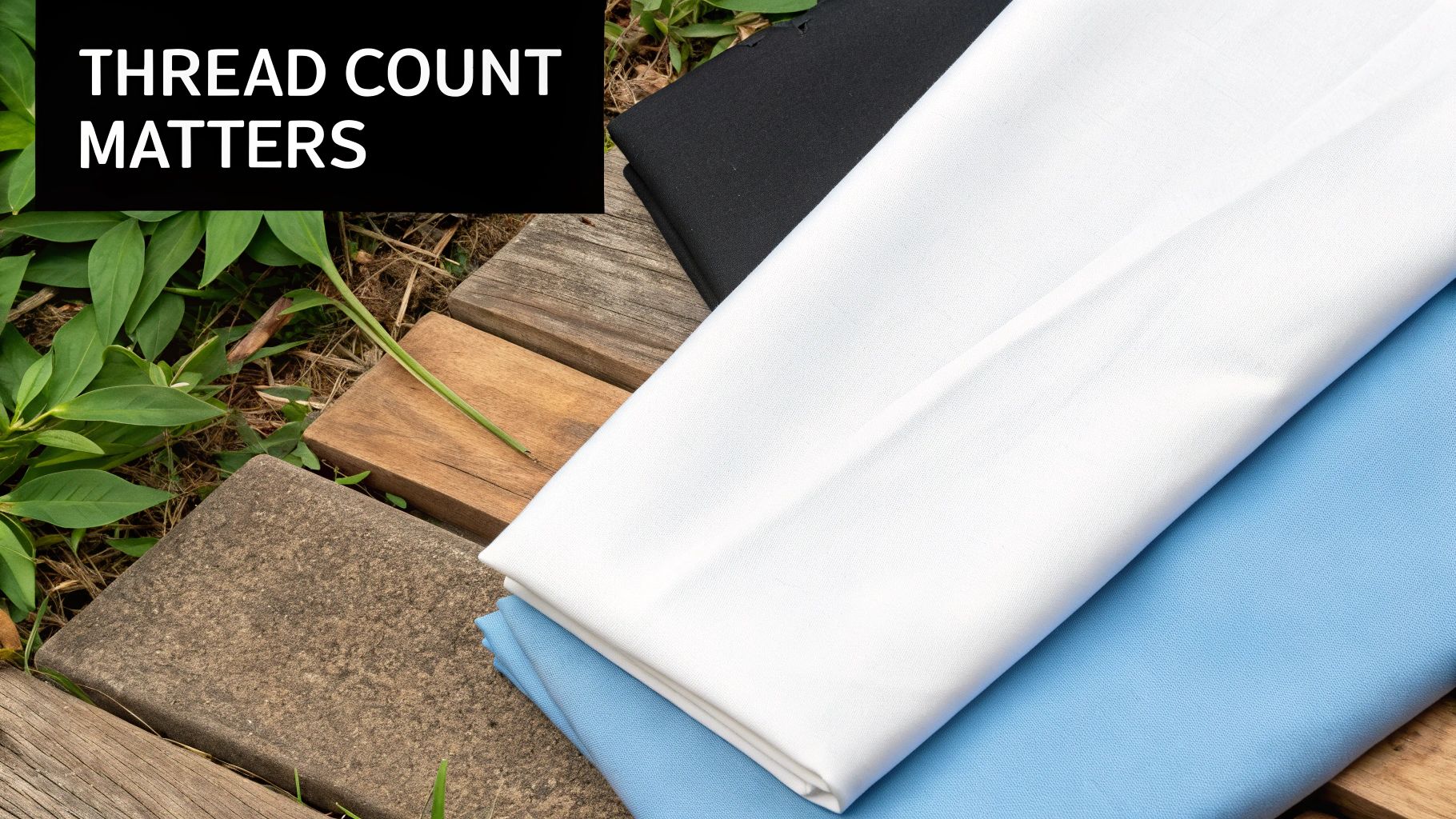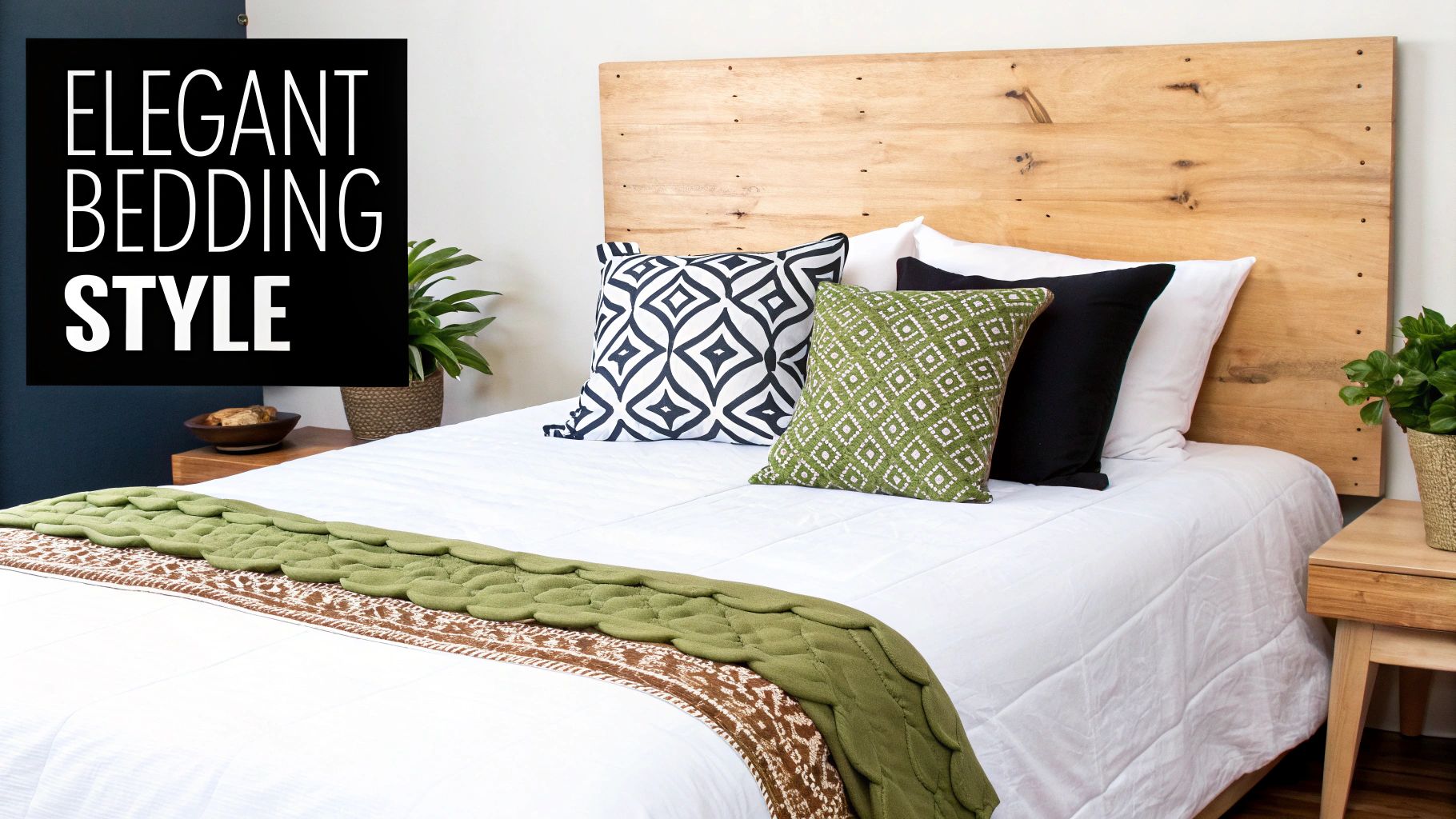Egyptian cotton sheets have a reputation for a reason. They're known for being incredibly soft, ridiculously durable, and breathable, which is why they've become the gold standard for luxury bedding. This isn't just marketing hype—it all comes down to the unique extra-long staple fibres of the cotton plant grown in Egypt, which create a fabric that's stronger, smoother, and frankly, just feels better than regular cotton.
Why Genuine Egyptian Cotton Is Worth It

So, what actually gives Egyptian cotton its legendary status? The secret is twofold: the specific plant it comes from—Gossypium barbadense—and the perfect growing conditions found in Egypt's Nile River Valley. This unique environment helps produce cotton fibres that are much, much longer than other varieties.
Think of it like trying to twist a rope together. If you only have short, frayed bits of string, the final rope will feel coarse, weak, and likely fall apart. But if you start with long, unbroken threads, you end up with a rope that’s incredibly strong and smooth. That’s the real difference with Egyptian cotton sheets.
The Power of Long-Staple Fibres
These extra-long staple (ELS) fibres are the building blocks of this amazing fabric. Because they're so long, they can be spun into exceptionally fine yet remarkably strong yarns. When these fine yarns are woven together, they create a material that feels uniquely smooth and supple against your skin.
This structure is what delivers all the key benefits you look for in true luxury bedding:
- Incredible Softness: The long, continuous fibres mean fewer exposed ends poking out of the weave, which gets rid of that scratchy feeling you find in lower-quality cottons.
- Lasting Durability: Sheets made from these strong, fine yarns resist pilling, tearing, and fraying. They're built to last for years without losing their beautiful feel.
- Superior Breathability: The fine weave allows air to move freely, wicking away moisture and helping to regulate your body temperature for a comfortable, non-sweaty night's sleep.
A key sign of genuine Egyptian cotton is that it actually gets softer with every wash. The water helps the fibres relax and plump up over time, enhancing their natural softness instead of wearing them down.
Navigating a Confusing Market
Unfortunately, the premium reputation of Egyptian cotton has also flooded the market with fakes and misleading labels. You’ll see plenty of products advertised as "Egyptian cotton" that are really just inferior, short-staple cotton blends. This is why getting your head around what makes the real stuff special is the first step to becoming a savvy shopper.
When you understand the value of true ELS fibres, you can look past the marketing fluff and focus on what really matters. To see how these principles apply to building a truly comfortable bed, our guide to luxury bedding sets in Australia offers more tips on picking out premium linens. By arming yourself with this knowledge, you can make sure your investment delivers the incredible comfort and longevity you expect from the real deal.
The Truth About Authenticity and Scarcity
The incredible reputation of Egyptian cotton has created a strange situation in the bedding world: while everyone wants it, very few sheets sold under the name are actually the real deal. The problem is simple supply and demand. The global appetite for these luxurious linens is massive, but the actual amount of genuine Gossypium barbadense cotton grown in the Nile River Valley is surprisingly small.
This scarcity has, unfortunately, thrown the doors wide open for a huge counterfeit market. Plenty of manufacturers slap the coveted "Egyptian cotton" label on their packaging, even when the sheets are made from inferior, short-staple cotton blends. This makes it incredibly tricky for shoppers to know if they're actually investing in the long-lasting quality they've been promised.
A Tale of Scarcity
To get a real sense of just how rare genuine Egyptian cotton is, you only need to look at the global production numbers. The truth is, Egypt isn't a major player in the worldwide cotton market. Its output is tiny compared to many other producers, which creates a huge gap between what’s grown and what’s sold under its famous name.
Put simply, the global demand for Egyptian cotton sheets is far, far greater than Egypt's actual cotton production. In recent years, Egypt's ranking has fallen, sometimes not even making the top 30 producers globally. For a bit of local perspective, Australia is a major cotton producer, often ranking 8th in the world and growing significantly more cotton than Egypt. This mismatch between low production and high demand is the main reason mislabelling is so common.
This infographic shows the relationship between low production, high demand, and the need for certification.
As you can see, this scarcity is what fuels the counterfeit market, making official verification a must-have for any shopper.
Why Verification Is Your Best Defence
With so many fakes out there, how can you be sure you’re buying the real thing? The most reliable way is to look for official certification. This is where organisations dedicated to protecting the integrity of the material become your best friend while shopping.
The Cotton Egypt Association (CEA) is the main guardian of the Egyptian Cotton™ trademark. They use a sophisticated DNA testing system to verify that products are made from 100% pure Egyptian cotton, all the way from the farm to the finished sheet.
When you see their official gold seal on the packaging, you can feel confident that the product has been scientifically checked and verified. That seal is a guarantee of authenticity. It confirms the extra-long staple fibres are present and that you're getting the superior softness and durability you paid for.
Without this certification, you’re essentially taking a gamble. For those looking for verified quality, exploring a curated range like the Sheridan Luxury Egyptian Cotton Collection is a great place to start.
Ultimately, the scarcity of authentic Egyptian cotton is what makes it a true luxury. By understanding the reality of production and the importance of certification, you can navigate the market with confidence and make sure your investment rewards you with years of incredible comfort.
Decoding Thread Count and Fabric Weave

When you start shopping for Egyptian cotton sheets, you'll see two terms pop up everywhere: thread count and weave. These concepts are often buried in marketing jargon, making it tricky to know what you’re actually buying. But understanding them is the secret to choosing sheets that feel just right for you.
For years, the bedding industry has pushed one simple message: the higher the thread count, the better the sheets. This has led to a race for mind-boggling numbers, with some labels boasting counts of 1,000, 1,200, or even higher. Honestly? It's one of the biggest myths in the world of textiles.
The Truth About Thread Count
Think of thread count like the megapixels on a digital camera. A camera with a huge megapixel count sounds impressive, but if the lens is blurry and the sensor is cheap, all you get is a bigger, blurrier, low-quality picture. The exact same principle applies to sheets.
An ultra-high thread count means nothing if the cotton itself is poor quality. Manufacturers can easily inflate these numbers by using thin, weak, short-staple fibres twisted together into multi-ply threads. While this technically crams more threads into a square inch, the fabric it creates is often heavy, less breathable, and likely to start pilling after a few washes.
For genuine extra-long staple Egyptian cotton, quality always trumps quantity. The natural strength and fineness of the fibres mean you don’t need an inflated thread count to get that luxurious feel. The sweet spot is typically between 400 and 800.
Within this range, the fabric is incredibly soft and durable, yet still feels lightweight and breathable. It’s a balanced construction that lets the superior quality of the cotton do all the work. For a deeper dive, you can explore more about understanding thread count and if it really matters in our detailed guide.
Choosing Your Perfect Fabric Weave
Just as important as thread count is the fabric’s weave. This is what determines the final texture and feel of the sheets against your skin. The two most popular weaves for Egyptian cotton are percale and sateen, and they offer completely different sleep experiences. The "best" one comes down to what you personally prefer.
To make it simple, we've broken down the key differences to help you decide which one suits your sleep style.
Weave Characteristics at a Glance
| Weave Type | Feel & Texture | Best For | Appearance |
|---|---|---|---|
| Percale | Crisp, cool, and airy. Think of a freshly ironed dress shirt. | Hot sleepers or warm Aussie climates. Anyone who loves that "cool side of the pillow" feeling. | Smooth and matte with no shine. |
| Sateen | Silky, buttery-soft, and smooth with a luxurious drape. | Those who prefer a warmer, cosier bed or love a silk-like feel without the slip. | A subtle, elegant lustre or sheen. |
Ultimately, choosing between them is a matter of touch and temperature. If you love the crisp, cool feeling of high-end hotel bedding, percale will be your perfect match. But if you crave a silky, smooth, and slightly warmer feel that drapes beautifully, you will fall in love with sateen.
How to Spot and Buy Authentic Sheets
Navigating the world of luxury bedding can feel a bit overwhelming, especially when you hear stories about fakes. But honestly, with a little know-how, you can easily tell the real deal from the imposters. Making a confident purchase just comes down to knowing what to look for—from official certifications to the actual feel of the fabric.
Think of yourself as a quality detective. Your first and most obvious clue is always on the packaging. Good brands are proud of their product's authenticity and aren't afraid to show it.
Look for the Official Seal of Approval
The single most trustworthy sign you can find is the official Egyptian Cotton™ logo from the Cotton Egypt Association (CEA). This gold seal isn't just a fancy sticker; it's a guarantee. The CEA uses a scientific DNA verification process to trace the cotton all the way from the farm in the Nile River Valley right through to the finished product on the shelf.
When you see this logo, you know the sheets are made from 100% pure, extra-long staple Egyptian cotton. If that seal is missing, you should definitely be a bit sceptical. It’s the clearest proof that you're investing in the real thing.
Scrutinise the Product Label
Next up, have a good look at the label's wording. Vague marketing terms are a massive red flag. Phrases like "Egyptian cotton blend," "Egyptian feel," or "luxury sateen" are often used to hide the fact that the product contains cheaper, short-staple cotton or even synthetic fibres.
Authentic products will be specific and totally transparent. Look for these exact phrases on the label:
- 100% Egyptian Cotton
- 100% Long-Staple Egyptian Cotton
- Made from Extra-Long Staple (ELS) Fibres
Anything less precise is a reason to pause. Genuine manufacturers have nothing to hide and will state the material composition clearly and proudly.
Trust Your Sense of Touch
While it’s trickier when shopping online, the physical feel of the fabric is another powerful clue. Real Egyptian cotton sheets have a distinct texture. They should feel incredibly smooth and soft, but also substantial and strong, which comes from those long fibres.
A common misconception is that authentic sheets feel thick or heavy. In reality, high-quality Egyptian cotton is known for being lightweight and breathable while still being incredibly durable. It feels supple and drapes beautifully, unlike the stiff or coarse texture you get with lower-grade cottons.
If the fabric feels rough, stiff, or unusually thin, it’s probably not made from true ELS fibres.
Consider the Price and Origin
Finally, be realistic about the price. True Egyptian cotton is a premium, relatively scarce material, and its price tag reflects the quality and the complex production process behind it. If you stumble upon a set of "Egyptian cotton sheets" at a suspiciously low price, it’s almost certainly too good to be true.
Check the country of origin, too. While the raw cotton must come from Egypt, the sheets themselves can be manufactured elsewhere. The key here is transparency. Reputable brands will clearly state where their products are made, and this level of detail is a good sign you're dealing with a trustworthy company. Making a smart choice involves more than just reading labels; you can learn more by buying the right bed sheets with our ultimate guide.
The demand for these premium textiles is growing quickly here in Australia, with data showing a 68% year-on-year increase in Egyptian cotton product imports. This rising interest just highlights how important it is for shoppers to be able to spot the real deal in a crowded market. By following these steps, you can be sure your investment brings home the lasting comfort and luxury you deserve.
Proper Care for Long-Lasting Luxury
Investing in a beautiful set of Egyptian cotton sheets is one thing; knowing how to care for them so they last is another. The good news? Unlike other fabrics that get thinner and scratchier over time, genuine Egyptian cotton actually gets softer and cosier with every wash. Think of it like a fine wine—it just gets better with age, but only if you treat it right.
The secret is all in those extra-long staple fibres. When you wash them correctly, the fibres relax and plump up, which is what gives them that famously soft feel without causing any damage. A simple care routine is all it takes to protect these delicate fibres, maintain their strength, and guarantee years of incredible comfort.
The Washing Process Simplified
The golden rule for washing your Egyptian cotton sheets is to be gentle. Harsh chemicals and high heat are the biggest enemies of these fine fibres. For the best results, always wash your sheets on their own, away from anything with zippers or rough textures that could snag the fabric.
Follow these simple steps for a perfect wash every single time:
-
Separate Colours Wisely: Always wash whites separately from colours to stop any dye from bleeding. Because Egyptian cotton is so absorbent, it can easily pick up stray dyes from other items in the wash.
-
Choose the Right Temperature: Stick to cool or warm water, ideally around 40°C. Hot water can cause the delicate fibres to weaken over time and might even lead to a bit of shrinkage.
-
Select a Gentle Detergent: A mild, pH-neutral liquid detergent is your best friend here. Powdered detergents don't always dissolve properly and can leave a residue, while harsh chemicals will break down the cotton fibres, making your sheets feel less soft.
Important Tip: Whatever you do, steer clear of fabric softeners and bleach. It sounds strange, but fabric softeners actually coat the cotton fibres with chemicals, which suffocates them and reduces their natural softness and breathability. Bleach is way too aggressive and will cause serious damage.
Drying for Maximum Softness
How you dry your sheets is just as important as how you wash them. The goal is to get the moisture out without "baking" the fibres, which can make them feel brittle and stiff.
Line drying is the absolute best way to preserve the feel of Egyptian cotton. Hanging your sheets outside in the shade lets them dry naturally, leaving them feeling fresh and crisp while keeping wrinkles to a minimum. It’s the gentlest method you can use.
If you have to use a machine dryer, just follow these guidelines:
- Use a Low Heat Setting: High heat is the fastest way to damage cotton fibres. Tumble dry on a low or delicate setting to protect the fabric's integrity.
- Don't Over-Dry: Pull the sheets out of the dryer while they are still just the tiniest bit damp. This stops them from going stiff and makes ironing a whole lot easier (if you choose to iron at all).
- Skip the Dryer Sheets: Just like liquid fabric softeners, dryer sheets coat the fibres in chemicals that get in the way of their natural softness and absorbency.
By following these simple washing and drying habits, you’ll make sure your Egyptian cotton sheets stay the soft, luxurious centrepiece of your bedroom for years. For more seasonal advice, you can learn about caring for your bed sheets this spring to keep them feeling fresh all year round.
Styling Your Bedroom with Premium Linens

Once you've sorted the technical bits of weaves and thread counts, it’s time for the fun part—styling your bedroom with the unmatched luxury of Egyptian cotton. These sheets are so much more than just a place to sleep; they’re the foundation for creating a bedroom that feels like a genuine retreat.
The right sheets can anchor your entire room's aesthetic, turning your bed from just a piece of furniture into a stunning centrepiece.
Your choice of weave makes a huge difference in setting the tone. A percale weave, with its crisp, matte finish, gives off a clean and airy vibe. It’s the perfect match for a minimalist, coastal, or Hamptons-inspired bedroom, creating that fresh, hotel-like elegance that feels both modern and timeless.
On the other hand, the subtle lustre of a sateen weave is perfect for a more classic or glamorous look. Its silky drape catches the light beautifully, adding a touch of opulence and warmth. This makes it a natural fit for rooms with rich textures or anyone wanting a cosier, more luxurious atmosphere.
Choosing Your Colour Palette
Colour is one of the most powerful tools for shaping the mood of a space, and your Egyptian cotton sheets are the perfect place to start. Whether you're after a serene sanctuary or something a bit bolder, your bedding sets the scene.
- Timeless Neutrals: For that calm, hotel-inspired escape, you can never go wrong with classic whites, soft creams, or gentle greys. These colours create a tranquil backdrop that lets other design elements in the room shine.
- Subtle Hues: Soft blues, gentle greens, and muted earth tones bring a sense of peace and a connection to nature. They're soothing and versatile, adding a touch of personality without overwhelming the space.
- Rich, Saturated Tones: To make a real statement, think about deep jewel tones like emerald, sapphire, or charcoal. These bold choices transform your bed into a focal point, creating an intimate and wonderfully cosy environment.
The right colour palette isn’t just about personal style; it’s about how a space makes you feel. A well-chosen hue can make a room feel larger, warmer, or more peaceful, proving that great design is so much more than just looks.
Mastering the Art of Layering
The secret to that plush, magazine-worthy bed? It's all in the layering. It's a simple technique that adds depth, texture, and a sense of inviting comfort. Think of your Egyptian cotton sheets as the smooth, luxurious base, and then just build from there.
Start by folding your flat sheet over your duvet or quilt for a clean, classic hotel look. Next, add texture and warmth with a folded throw blanket or a stylish coverlet draped across the foot of the bed. This is a great chance to bring in a complementary colour or a different material, like wool or linen, for a bit of visual interest.
Finish it all off with an artful arrangement of pillows. Start with your sleeping pillows, then layer on two European square pillows for height, and finally, add one or two smaller decorative cushions in different shapes or textures. It’s a simple combination that creates a look of effortless style and comfort.
In the competitive Australian bedsheet market, valued at around USD 2,236 million, premium materials like Egyptian cotton really stand out. As more people look for both comfort and durability, knowing how to style these superior linens ensures you get the most from your investment. You can find more details about how luxury and eco-friendly materials are shaping the Australian market here.
With a few simple styling techniques, your new sheets become more than just bedding—they become the cornerstone of a beautifully designed and restorative bedroom.
Common Questions About Egyptian Cotton
Even after diving into all the details, a few questions tend to pop up just before you decide to invest in a set of premium sheets. Getting clear, simple answers can make all the difference, helping you feel completely confident that you’re making the right choice.
Are Egyptian Cotton Sheets Really Better?
Yes, when they’re the real deal, they absolutely are. It’s not just clever marketing; the difference is woven right into the cotton itself. The extra-long staple fibres create yarns that are both incredibly fine and remarkably strong.
This unique combination results in a fabric that’s noticeably softer, more durable, and far more breathable than your standard cotton. While other great materials like Pima cotton or high-quality bamboo have their own perks, the buttery softness and lasting strength of genuine Egyptian cotton is what truly sets it apart.
Why Do My New Sheets Feel a Bit Stiff?
It's completely normal for brand-new Egyptian cotton sheets to feel a little crisp straight out of the packet. This is usually down to the finishing process used in manufacturing, which helps keep them looking smooth and neat during shipping.
The real magic of Egyptian cotton is that it only gets better with time. With every wash, those long fibres relax and soften, meaning your sheets will become progressively cosier and more luxurious the more you use them.
Think of it as the opposite of cheap sheets that start out soft but turn scratchy and thin after just a few months. Your new sheets are just getting started on their journey to peak softness.
How Can I Be Sure I Am Not Buying a Counterfeit Product?
That’s a fair question, especially with so many fakes on the market. The most reliable way to know you're getting the genuine article is to look for official certification. The Cotton Egypt Association (CEA) issues a gold seal with a unique serial number, which guarantees the product is made from 100% pure Egyptian cotton.
Beyond that, get into the habit of reading the label. Look for specific wording like "100% Long-Staple Egyptian Cotton" and be cautious of vague terms like "Egyptian blend." Lastly, trust your gut on the price—if a deal seems too good to be true, it almost certainly is. Authentic quality has a price tag to match.
Is a Higher Thread Count Always a Sign of Better Quality?
Not at all. This is probably the biggest myth in the entire bedding industry. While thread count tells you how many threads are in a square inch of fabric, it says nothing about the quality of those threads. It's easy for manufacturers to inflate this number by twisting together multiple thin, weak yarns.
For genuine Egyptian cotton, the sweet spot for thread count is usually between 400 and 800. In this range, the fabric is breathable, long-lasting, and beautifully soft. It allows the quality of the long-staple fibres to do their job without making the sheets feel heavy or stiff.
Ready to feel the difference for yourself? Explore the beautiful range of bedding at Manchester Factory and discover the perfect sheets to transform your sleep. Find your new favourite set today at https://www.manchesterfactory.com.au.

